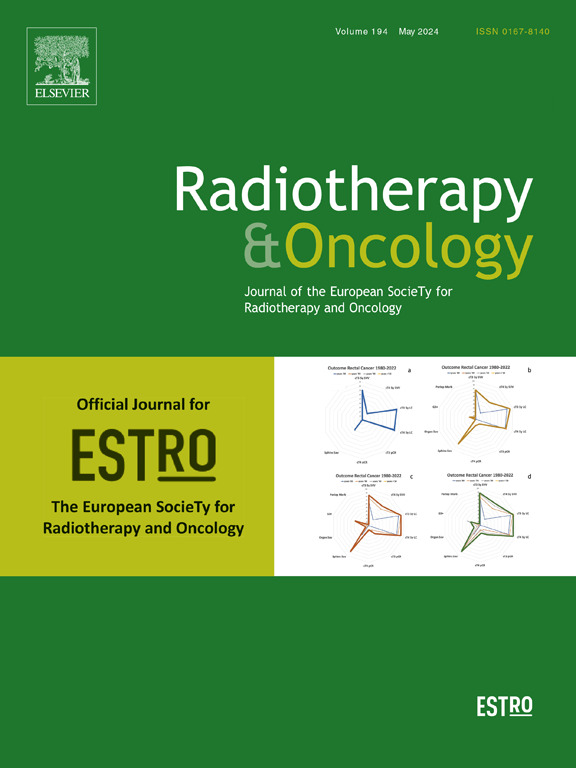头颈癌放疗中动态血液剂量与临床疗效的相关性。
IF 4.9
1区 医学
Q1 ONCOLOGY
引用次数: 0
摘要
背景和目的:癌症放疗期间的放射诱导淋巴细胞减少症(RIL)因其与不良临床结果相关而日益受到关注。在多个治疗部位,RIL 与较差的局部区域控制(LRC)、无远处转移生存率(DMFS)和总生存率(OS)之间的相关性已得到证实。循环血液或淋巴细胞中的辐射量估计值已被证明与严重RIL相关。本研究旨在评估血液剂量估计值是否同样与患者预后直接相关:对于 298 名头颈部癌症患者,通过全身剂量(Dbody)、考虑到相关器官和组织平均剂量的静态血液剂量模型(Dstatic)以及进一步包括血流和治疗时间等时间因素的动态模型(Ddynamic)来估算血液剂量。后者采用了血液剂量(HEDOS),这是一种用于血液剂量模拟的开源计算工具。研究人员进行了生存分析,以评估血液剂量与LRC、DMFS和OS之间的潜在相关性:结果:多变量 Cox 回归分析发现,血液剂量与 LRC、DMFS 和 OS 之间存在统计学意义上的显著相关性(p 体),而 Dstatic 与所考虑的任何结果均无相关性:结论:动态血液剂量模型与不良临床结果之间存在统计学意义上的相关性。在多变量回归分析中,静态血液剂量模型与所研究的任何结果都没有统计学意义上的显著相关性。本文章由计算机程序翻译,如有差异,请以英文原文为准。
Correlation of dynamic blood dose with clinical outcomes in radiotherapy for head-and-neck cancer
Background and purpose
Radiation-induced lymphopenia (RIL) during cancer radiotherapy is receiving growing attention due to its association with adverse clinical outcomes. Correlations between RIL and poorer locoregional control (LRC), distant-metastasis-free survival (DMFS), and overall survival (OS) have been demonstrated across multiple treatment sites. Estimates of radiation delivered to circulating blood or lymphocytes have been shown to be correlated with severe RIL. This study aims to evaluate whether blood dose estimates are equally correlated with patient outcomes directly.
Materials and methods
For 298 head-and-neck cancer patients, blood dose was estimated via the total body dose (Dbody), a static blood dose model considering the mean dose to relevant organs and tissues (Dstatic), and a dynamic model which further included temporal aspects such as blood flow and treatment delivery time (Ddynamic). The latter utilized hematological dose (HEDOS), an open-source computational tool for blood dose simulations. Survival analysis was performed to evaluate potential correlations between blood dose and LRC, DMFS, and OS.
Results
Multivariable Cox regression analysis found a statistically significant (p < 0.05) correlation between various dynamic blood dose metrics and clinical outcomes. Dbody and Dstatic did not correlate with any of the outcomes considered.
Conclusion
A statistically significant correlation between the dynamic blood dose model and adverse clinical outcomes was observed. During multivariable regression analysis, neither static blood dose model exhibited a statistically significant correlation with any of the outcomes studied.
求助全文
通过发布文献求助,成功后即可免费获取论文全文。
去求助
来源期刊

Radiotherapy and Oncology
医学-核医学
CiteScore
10.30
自引率
10.50%
发文量
2445
审稿时长
45 days
期刊介绍:
Radiotherapy and Oncology publishes papers describing original research as well as review articles. It covers areas of interest relating to radiation oncology. This includes: clinical radiotherapy, combined modality treatment, translational studies, epidemiological outcomes, imaging, dosimetry, and radiation therapy planning, experimental work in radiobiology, chemobiology, hyperthermia and tumour biology, as well as data science in radiation oncology and physics aspects relevant to oncology.Papers on more general aspects of interest to the radiation oncologist including chemotherapy, surgery and immunology are also published.
 求助内容:
求助内容: 应助结果提醒方式:
应助结果提醒方式:


